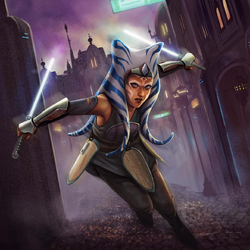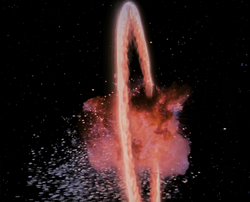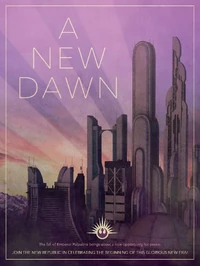- "Back in the early days, before the Rebellion formally existed, a lot of guerrillas got their hands dirty doing things no one else wanted to do—or even think about. The Alliance would never have existed without them, Princess. Those men and women were my mentors—I've spent my entire career trying to live up to their example."
- ―Major Lokmarcha, to Leia Organa
Between the Clone Wars and the Galactic Civil War, an early rebellion in the early years of the reign of the Galactic Empire was waged by a collection of rebel cells that ultimately formed the Alliance to Restore the Republic. These militant cells were covertly organized by Senator Bail Organa of Alderaan and quietly given political support in the Imperial Senate by such senators as Mon Mothma of Chandrila and Leia Organa of Alderaan. Major rebel cells included the Massassi Group led by General Jan Dodonna, Phoenix Cell led by Commander Jun Sato, the Spectres led by Captain Hera Syndulla, and the Partisans led by resistance fighter Saw Gerrera. They were often supported by agents known as Fulcrum, including Commander Ahsoka Tano.
The early rebellion against the Empire originated in the last days of the Galactic Republic, when Senator Organa and other members of the Galactic Senate convened in secret to discuss ways to counter the executive power amassed by Supreme Chancellor Sheev Palpatine. When the Clone Wars, a pretext for Palpatine to amass power, came to an end in 19 BBY, the Republic was transformed into the Galactic Empire and Organa began organizing armed resistance against the Imperial regime. By 4 BBY, many resistance cells began working together after they aided in the rescue of the captive Jedi Kanan Jarrus over Mustafar.
The battle marked the outbreak of the fully open Galactic Civil War, in which the Alliance ultimately triumphed over the Empire and formed the New Republic.
Prelude[]
- "We cannot let a thousand years of democracy disappear without a fight."
- ―Senator Bail Organa, during the last days of the Galactic Republic
In 22 BBY,[27] in response to the growing threat that the Confederacy of Independent Systems represented to the stability of the Galactic Republic, the Galactic Senate granted Supreme Chancellor Sheev Palpatine emergency executive power to raise the Grand Army of the Republic and wage the Clone Wars against the Separatists.[28] Palpatine, secretly the Sith Lord Darth Sidious who was using the conflict as a pretext for galactic domination, amassed almost total power during the three-year conflict.[1] Numerous senators, including Bail Organa of Alderaan and Mon Mothma of Chandrila, were alarmed by the increasingly-dictatorial moves of the Supreme Chancellor and began meeting in secret to discuss how to counter centralized power.[29] At the end of the war, in the name of peace and security, Palpatine declared himself Emperor and transformed the Republic into the Galactic Empire and the Galactic Senate into the Imperial Senate.[1]

Senators Bail Organa and Mon Mothma began laying the foundations for rebellion during the Clone Wars.
In the years after the Clone Wars, disconnected resistance movements began to crop up throughout the galaxy to combat the Empire. Berch Teller, a former Republic Intelligence captain and defected member of the Imperial Military, led a cell that stole the Carrion Spike, the personal starship of Governor Wilhuff Tarkin. Their actions targeted operations related to the secret construction of the Death Star, an Imperial superweapon capable of destroying entire planets, and were in response to the Empire's actions during the Antar Atrocity a few years earlier.[2] Another resistance cell, the Free Ryloth Movement, was led by General Cham Syndulla on Ryloth. The cell, focused only on liberating Ryloth, attempted to kill Emperor Palpatine and his right-hand, Lord Vader, by attacking the Star Destroyer Perilous.[30] Neither the actions of Teller or Syndulla succeeded in achieving their goals, but they represented some of the first attempts to combat Imperial rule.[2][30]
History[]
Early campaigns[]
- "I want to take your recruits and find missions for them. I want to be the one who listens to what people need, who finds out what people can do and then helps them do it."
- ―Ahsoka Tano, to Bail Organa
In 18 BBY,[31] Emperor Palpatine caught wind of a Jedi's surmissed interference in the affairs that concerned the Empire and Mon Cala. In an effort to show the galaxy the price of defiance by making an example of the ocean world, the Dark Lord of the Sith and Commander-in-Chief Darth Vader was appointed to oversee the hunt for King Lee-Char's Jedi advisor, while Moff Wilhuff Tarkin managed the standard military aspects. Eventually, the Dark Lord killed the elusive Force-user, former Padawan Ferren Barr, and arrested the King just as the Governor had finished the assault. Though a handful of Mon Calamari merchant ships escaped and would go on to play a key role in the later rebellion, Mon Cala was successfully subjugated by the Empire,[32] whereas its monarch was imprisoned on Strokill Prime.[33]
In those early days of the rebellion, Senator Organa worked with members of the Alderaan Guard to identify resistance movements across the galaxy and find Jedi who might have survived the fall of the Jedi Order at the end of the war. Eventually, the Viceroy of Alderaan heard of an uprising on Raada in the Outer Rim Territories that was rumored to have been led by a Jedi. Organa discovered that the Force-wielder in question was Commander Ahsoka Tano, a former Padawan who had left the Jedi Order during the war after she had been falsely accused of bombing the Jedi Temple.[14]

Organa recruited Commander Ahsoka Tano to lead rebel intelligence, and she operated under the codename "Fulcrum."
After locating the former Padawan, Organa asked Tano to join his growing rebel movement, and she agreed on two conditions: that Organa help her discover the mysterious Imperial agents who were hunting Force-sensitive children, and that he help rescue her friends in the Raada resistance. Organa made good on his promise and sent his ship, the Tantive IV, and RZ-1 A-wing interceptors to evacuate her friends on Raada. Tano and the resistance members joined the rebellion, and Tano took on the role of finding missions for recruits. She became the leader of Organa's rebel intelligence and began operating under the codename "Fulcrum."[14]
Various rebel cells joined Organa's rebellion, dubbed the "Alliance" by Mon Mothma by 4 BBY,[34] over the years. Phoenix Cell, led by Commander Jun Sato, had a fleet of its own, along with a number of A-wing starfighters.[35] The Massassi Group, led by General Jan Dodonna, also had a large fleet and operated out of the Great Temple on Yavin 4.[19] Saw Gerrera, a resistance fighter trained by Jedi such as Commander Tano during the Clone Wars, led the Partisans in a number of campaigns.[36] The different cells had different ways of conducting themselves. Gerrera, for example, was more militant than other cells and was willing to take any action necessary in order to free the galaxy from the Empire. This put him at odds with leaders such as Organa[37] and Mothma,[38] and allowed members of the Empire to view rebel activities in a negative light. Agent Kallus of the Imperial Security Bureau recalled that one of his earliest missions was an attempt to pacify Onderon but he encountered brutal resistance from Gerrera and his Partisans.[39]
Prior to 4 BBY,[40] rebel cells generally did not work together or even know of one another's existence. This protocol ensured that if any cell was compromised by the Empire, the identities and locations of other cells would not be put into jeopardy.[41] Tano coordinated many of the activities and missions of several rebel cells under her Fulcrum codename, providing them with Imperial targets and supply opportunities.[42] One early example of coordinated activities was a joint operation between the Commenor Underground and the Partisans, around 10 BBY.[43] All the same, Gerrera[21] largely[44] kept the Partisans separate from other rebel factions, believing he alone had a clarity of purpose in the battle against the Empire and not wanting to put his fighters at risk for other groups.[21]
Growing signs of rebellion[]
- "There is a wound that won't heal at the center of the galaxy. There is a darkness reaching like rust into everything around us. We let it grow, and now it's here. It's here and its not visiting anymore. It wants to stay. The Empire is a disease that thrives in darkness. It is never more alive than when we sleep. It's easy for the dead to tell you to fight, and maybe it's true, maybe fighting is useless. Perhaps it's too late. But I'll tell you this… If I could do it again, I'd wake up early and be fighting these bastards… from the start. Fight the Empire!"
- ―Maarva Andor
In 5 BBY,[45] at least two resistance movements were active in the Atrivis sector, being the Atrivis Resistance Group, led by Travia Chan, and the Liberators, operating on Mantooine. The Liberators managed to seize the Imperial Mantooine garrison but shortly afterward, the Imperial Navy counterattacked, swiftly defeating the Liberators on Mantooine. The Atrivis Resistance Group remained active and soon joined Organa's rebellion.[16] By that same year,[7] the recently-promoted ISB Supervisor Dedra Meero had started to take notice of multiple high-level thefts aimed at securing Imperial equipment, which she suspected was part of an organized rebel effort.[15]
Similarly, Sergeant Linus Mosk, who served within the Imperial-aligned Preox-Morlana tactical forces and considered his organization to be the Empire's first line of defense, had taken notice of growing pockets of dissent on Corporate-affiliated planets.[46] After the human Cassian Jeron Andor murdered two members of the Pre-Mor Security Inspection team, Verlo Skiff and Kravas Drezzer, while searching for his sister Kerri on Morlana One,[7] Mosk and Deputy Inspector Syril Karn led the search for Andor on Ferrix, where their target was being recruited to the wider rebel movement by Luthen Rael,[47] who was establishing an alliance of rebel cells to begin a true fight against the Empire. Despite Gerrera's insistence on working alone with only his Partisans, he maintained ties with Rael, who sold equipment to Gerrera's effort.[21]
Rebellion on Lothal[]
- "Why did you come here?"
"Because of you, and your apprentice. Many in this system and beyond have heard your message. You gave them hope in their darkest times. We didn't want that hope to die." - ―Kanan Jarrus and Ahsoka Tano
By 5 BBY,[48] a growing rebellion on the planet Lothal, a vital production center for the Empire's expansion in the Outer Rim, was led by Captain Hera Syndulla of the Ghost and her Jedi companion Kanan Jarrus. Together, they organized a crew that included the Mandalorian warrior Sabine Wren, Lasat soldier Garazeb Orrelios, and the astromech droid Chopper. The crew grew to include Ezra Bridger, a Force-sensitive youth whom Jarrus took on as his apprentice. Their actions came under increased Imperial scrutiny when they rescued Wookiee slaves from the spice mines of Kessel. They were pursued by Agent Kallus, and the actions of the Jedi drew the attention of the Grand Inquisitor as he hunted down surviving Jedi.[12]

Organa learns about the Ghost crew.
Organa's droids, astromech droid R2-D2 and protocol droid C-3PO, encountered the Ghost crew on Garel as the rebels stole illegal weapons from the Empire. Artoo monitored the activities of these rebels and reported back to Organa, who took an interest in the growing rebellion on Lothal.[23] Captain Syndulla, who became aware of the protocols of the growing rebellion, began receiving missions from Fulcrum. This caused some tension within the Ghost ranks, as Wren questioned who Fulcrum was and wondered why they were taking orders from a mysterious stranger. Per rebel protocol, they remained unaware of the existence of a larger rebellion against the Empire.[42]
The rebellion on Lothal became enough of a problem for the Empire that now-Grand Moff Tarkin, Governor of the Outer Rim, personally traveled to Lothal to oversee an operation aimed at eliminating the Ghost crew once and for all. Tarkin was particularly concerned that the presence of the Jedi could inspire the people of Lothal to put their faith in something other than the strength of the Empire. The rebels undertook an operation to infiltrate the Imperial Communications Center on Lothal and broadcast a message to the planet's citizens to bring the people hope. Tarkin and the Empire were ready for the rebel incursion and captured Jarrus, but the rebels were able to broadcast a message of hope and tell the people of Lothal that the rebels were fighting for the freedom of all the people.[25]

Phoenix Squadron arrives at Mustafar to help the Ghost crew escape from the Empire.
The Ghost crew wanted to find a way to rescue Jarrus, but Tano ordered Syndulla to lay low. In defiance of Fulcrum and Syndulla, Bridger led the other rebels in discovering that Jarrus was being taken to Mustafar, a volcanic planet that Jarrus had once told Syndulla was a place where Jedi were taken to die.[49] The rebels mounted a rescue mission, one in which Jarrus and Bridger faced off against the Grand Inquisitor aboard Tarkin's Star Destroyer, the Sovereign. Jarrus defeated the Grand Inquisitor, who fell to his death during their battle, and the rebels fled from the Sovereign. They were nearly killed before the timely arrival of Tano and Phoenix Squadron, who were inspired by the message the rebels sent to Lothal and surrounding star systems and decided to help rescue Jarrus. The Ghost crew finally met another cell and Tano face to face, and Tano told them that the protocol had changed: the cells were beginning to work together as a rebellion.[41]
The loss at Mustafar, including the destruction of the Sovereign, was an embarrassing defeat for the Empire[41] and Grand Moff Tarkin.[50] In answer to the blow dealt by the insurgents, the Emperor's Fist, Lord Vader himself, was assigned to see to the quelling of the rebel activities on Lothal in consultation with Governor Tarkin, with Agent Kallus and the planetary government at their disposal. Meanwhile, the Ghost crew joined Phoenix Squadron and the two cells began working together as one.[35]
Legacy[]
- "There are whispers from Mustafar. Some people see the Empire as weak and vulnerable."
- ―Alexsandr Kallus reports the status of Lothal to Wilhuff Tarkin after the action at Mustafar

The theft of the Death Star plans led to the rebel victory at Yavin
The action at Mustafar had occurred as part of the Galactic Civil War,[10] a five-year conflict between the Galactic Empire and the Alliance to Restore the Republic.[51] On Lothal alone, the rebel victory at Mustafar was enough to spread anti-Imperial sentiment and unrest, creating rumors amongst the populous that the Empire had weakened and thus was vulnerable to attack.[41] Such a public rebel triumph forced the Empire to step up its efforts against the rebel cells scattered throughout the galaxy. In the aftermath of the Ghorman Massacre[50] in 2 BBY,[52] Senator Mon Mothma believed there was no hope left for the Imperial Senate and resigned, leading to her effort to escape Imperial forces in Operation Handoff. Over the planet Dantooine, Mothma rallied the scattered cells across the galaxy into the unified Alliance to Restore the Republic.[50]
The Empire's victory in the Battle of Atollon[53] of 2 BBY[52] left Mothma with the belief that the Alliance was not yet prepared for open war, but she also recognized there were others who believed open conflict had already begun.[53] The Battle of Scarif marked the Alliance's first major victory of the Civil War. Seeking to recover the Death Star plans, Lord Vader pursued Princess Leia to the planet Tatooine. Despite her capture, Leia managed to hide the plans in R2-D2, who was jettisoned alongside C-3PO to the planet's surface with the task of delivering them to Obi-Wan Kenobi. Unveiling the Death Star's full power, Governor Tarkin destroyed the planet Alderaan to punish its leaders for aiding the Rebellion. Preferring to rule by fear and terror, the Emperor dissolved the Imperial Senate and delegated power to regional governors. Instead of frightening the galaxy into submission, the destruction of Alderaan only fanned the flames of rebellion.[54]
After the plans were delivered, the droids, Kenobi and Skywalker teamed up with the smuggler Han Solo, and the Wookiee co-pilot Chewbacca to rescue Princess Leia from the Death Star. They then delivered the Death Star plans to the Rebel Alliance base on Yavin 4. Seeking to crush the Rebellion once and for all, Governor Tarkin brought the Death Star to Yavin 4. However, the Alliance discovered that the Death Star's flaw was an exposed thermal exhaust port. Following a fierce space battle, Skywalker fired a missile down the thermal exhaust port. The destruction of the Death Star marked an important victory for the Rebel Alliance.[54]

The rebels fought to restore the Republic
For the next five years, the Empire and Alliance battled for control of the galaxy. Despite victories such as the Battle of Hoth, the Empire failed to crush the Rebellion.[55] Undeterred by the loss of the Death Star, Palpatine commissioned the creation of a second Death Star over the Forest Moon of Endor. Seeking to crush the Rebel Alliance once and for all, the Emperor lured the Alliance fleet into a trap at Endor in 4 ABY. However, rebel ground forces and their local Ewok allies destroyed the planetary shield generator; allowing the Alliance to destroy the superweapon. To save his son Luke, Vader killed Palpatine, thus restoring balance to the Force.[56]
Following the Battle of Endor, the Rebel Alliance reorganized itself into the New Republic. The deaths of Emperor Palpatine and Lord Vader triggered the collapse of the Empire and the new government quickly consolidated control over large areas of the galaxy.[57] While a powerless Grand Vizier Mas Amedda officially ruled the Empire from Coruscant, much of the Empire was actually in the hands of Fleet Admiral Gallius Rax. As the Emperor's designated successor, Rax implemented the Palpatine's posthumous Contingency plan to tear down the Empire and to bring a worthy elect into the Unknown Regions to start afresh.[58] Following feigned peace talks on Chandrila,[59] Rax orchestrated the Battle of Jakku as the final showdown between the Empire and the New Republic.[58]
The self-styled Counselor to the Empire intended to implode the planet Jakku with Sith relics in order to destroy the massed Imperial and New Republic fleets. However, he was stopped by Grand Admiral Rae Sloane with the help of New Republic operatives. With the Empire defeated, Sloane and other Imperial officers fled into the Unknown Regions to regroup. Meanwhile, the New Republic signed the Galactic Concordance with Lord Amedda, formally ending the Galactic Civil War.[58] While the New Republic turned its attention to reshaping the galactic order, the Imperial Remnants consolidated themselves as the First Order, a military junta that was dedicated to restoring the Galactic Empire.[60] In 34 ABY, Cold War tensions between the New Republic, the allied Resistance paramilitary outfit, and the First Order culminated in open warfare between the First Order and the Resistance,[61] paving the way for the open return of the reborn Emperor on the enclave world of Exegol.[62]
Behind the scenes[]
The early rebellion against the Galactic Empire first appeared in the 2014 online browser Star Wars Rebels: Ghost Raid.[63]
Appearances[]
Non-canon appearances[]
 LEGO Star Wars: Droid Tales — "Mission to Mos Eisley" (In flashback(s))
LEGO Star Wars: Droid Tales — "Mission to Mos Eisley" (In flashback(s))
Sources[]
Notes and references[]

